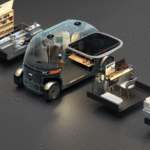A recent study led by researchers at Queen Mary University of London offers insights into the solute transport and solidification mechanisms in additive manufacturing, potentially enhancing the development of new materials and processes for 3D printing.
The research, conducted in collaboration with Shanghai Jiao Tong University, Centre of Excellence for Advanced Materials, and University of Leicester, and published in Nature Communications, focuses on solute trapping during rapid solidification in AM. This phenomenon, likened to adding a secret ingredient to a recipe, results in the concentration of solute elements at the solidification front, impacting the microstructural integrity of AM parts.

The study employs a computational model to explore solute transport amid the rapid thermal cycles characteristic of AM. Findings indicate that melt convection promotes solute trapping by diluting partitioned solute at the solidification front, leading to transitions from ultra-fine to coarse cell microstructures. These insights provide a pathway to reduce crack susceptibility in AM parts, particularly by accelerating the solidification process. Moreover, the detailed solidification pathway revealed in the study holds promise for the printability of ‘hard-to-print’ superalloys and could significantly influence future materials design for improved 3D printability.
Funded by the Engineering and Physical Sciences Research Council (EPSRC) and the National Natural Science Foundation of China (NSFC), this study marks a step towards understanding and mitigating defects in 3D printed components. The implications of this research may extend to the creation of stronger, more reliable, and complex 3D printed components, potentially transforming material design strategies in the AM industry.
You can read the research paper titled “Solute trapping and non-equilibrium microstructure during rapid solidification of additive manufacturing” at this link.
Come and let us know your thoughts on our Facebook, X, and LinkedIn pages, and don’t forget to sign up for our weekly additive manufacturing newsletter to get all the latest stories delivered right to your inbox.









